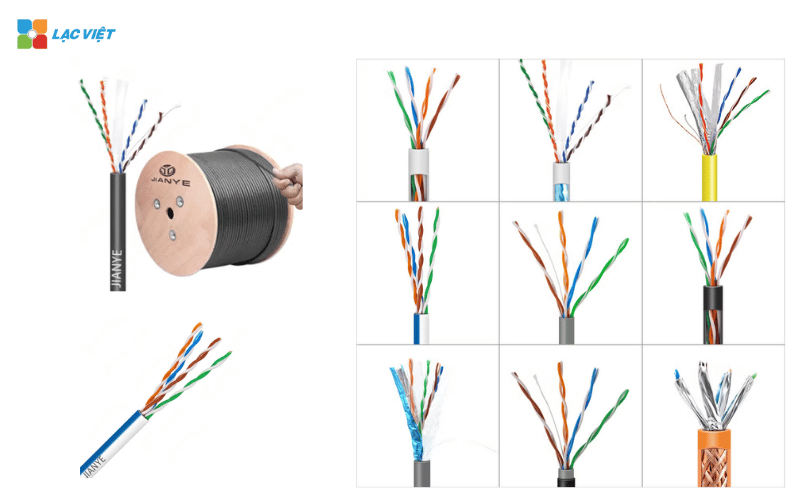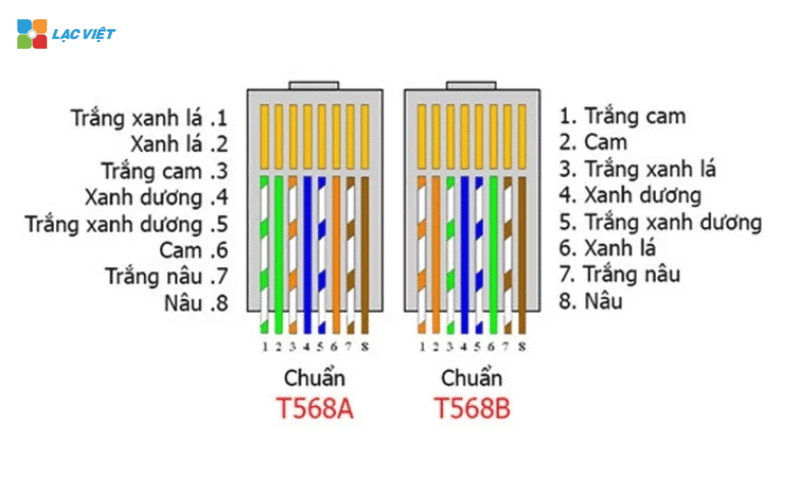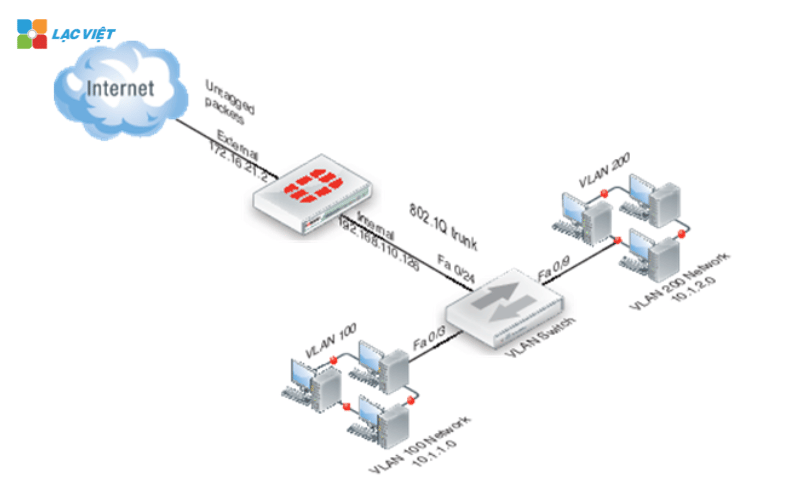In the era of transformation of system, network play the role as the “backbone” of all business operations, from internal communication to data processing and provide services to clients. A network system is constructed with the non-standard can lead to interruptions, repair costs, rising security risks seriously.
This article will help the business to understand about standard construction system network – the key element to ensure the system stable operation, high performance, easy to expand in the future. The same Lac Viet Computing keep track of the standards should adhere to, the benefit of applying the common mistakes to avoid to build a network system to meet all business needs.
1. Standard construction system network is what?
1.1. Standard definition
Standard construction system network is the set of rules, instructions are global recognition, to ensure the design process, installation and commissioning of the system network of the highest quality. These standards cover every aspect from the physical layout, equipment selection, to optimize performance, security.
For example, the standard ANSI/TIA-568 detailed regulations on cable network, connect and test the signal to ensure the ability to transmit accurate data in different environments. By applying these standards, the enterprise does not only optimize the cost but also guarantee network system ready for the long-term development.
The common standard in the construction system network
- ISO/IEC 11801: international standards of infrastructure cables general for the internal network.
- ANSI/TIA-568: The standard design and construction of infrastructure, network cable, optical.
- BICSI: The guide, network construction, ensuring optimal performance and safety.
Apply the correct standard is the business strategy to help businesses optimize operational processes and create a solid foundation for the future.

1.2. Benefits of compliance with the construction standards system network
Enhance optimal performance stable
- Stable transmission: construction standards help limit the attenuation signal, reducing latency, increasing data transfer rate. This is especially important with applications require high bandwidth, such as online conferencing or cloud.
- Optimal resource system: the System is designed to optimize resources, reduce the load for the device and limit conflicts of signal.
Cost savings long term
- Reduce maintenance costs: A system of standard less trouble than help reduce the cost of repair or upgrade.
- Increase equipment life: operating Environment standards longevity network devices like switch, router, server.
In compliance with the standard construction business can easily upgrade the system without the need for re-design the whole, save time and cost.
Meet the expansion needs in the future
- Design flexibility: A system network standard is always to consider the possibility of extension, from adding equipment to upgrade the bandwidth.
- Support new technology: The modern standards ensure system readiness integrated with technology, IoT, AI, or solution remote administration.
Security optimization: standard network help minimize security risks by integrating the design process and the configuration is suitable, from which protect business data from cyber attacks.
Compliance with legal provisions and partners: Many large enterprises requires partners to have network system comply with international standards such as ISO/IEC 11801 or BICSI to ensure compatibility and safety connect.
- Construction LAN internal quotation construction system LAN STANDARD on the market
- Process construction and installation of network systems & construction unit credits
- System maintenance network consists of items whatsoever? The maintenance process STANDARD
- System design, networking is what? 4 Steps network design for enterprise SECURITY
2. Sorting standard in the construction system network
To system network stable operation, enterprises need to comply with many standards construction systems, different networks. These standards do not only focus on equipment or technology but also extended to the process of installation, operating environment and security.
2.1. Standards of physical design
Physical design is the foundation of the network, decide the layout of cables, equipment and other components.
Layout guidelines network cable
- Network cable should be placed in conduit to protect from bumps or interference from electrical equipment.
- Compliance with the maximum distance for cable Cat5e and Cat6 (usually no more than 100m) to ensure the signal is not impaired.
Install the device in a rack cabinet
- Equipment should be arranged, science accessible for maintenance. For example, Switch located near area cable to optimize the connection.
- Ensure ventilation, cooling in the rack to avoid overheating, can reduce equipment life.

2.2. Standard hardware
Hardware standard will ensure compatibility enhance overall performance.
Network device (Switch, Router, Firewall): The device should support protocols such as IPv6, PoE, QoS to meet the needs of networks of increasing complexity.
Network cable standard
- Use cable Cat5e or Cat6 for the environment, small and medium business. With the demand for higher speed cable, Cat6a or Cat7 is the optimal choice.
- For optical network, need to select the cable type SMF (Single-mode Fiber) or MMF (Multi-mode Fiber), depending on the bandwidth requirements.

2.3. Environmental standards
The installation environment can affect the durability and performance of network system.
Machine room (Server room)
- Maintaining the ideal temperature (18-24°C), humidity from 30 to 50% to avoid equipment breakdowns.
- Equipped with anti-dust system, anti-fire and a backup power source (UPS).
Outdoor area or public school
- Using a network cable, anti-water, anti-UV, protected with a rugged casing.
- Ensure earthing system best to protect the device before the incident power.
2.4. Standards of network security
Network security is the key factor to protect business data from threats.
- Install a firewall and VLAN: divide the VLAN to isolate groups of devices, or employees, to minimize the risk of spread attack the network.
- Coding and test access: encrypts data on the important communication channel. Use two-factor authentication (2FA) to increase the security when accessing the system.
Understanding and correctly apply the standard construction network system according to each aspect helps enterprises build network systems optimal both in terms of performance, security, and sustainability.

3. The steps for implementation of the network system according to the standard
Construction process network systems standard to ensure high performance, minimize risks in operation and maintenance. Here are the important steps that businesses should comply with:
Step 1. Surveys and needs analysis
Survey current status: reviews by other influencing factors such as power, temperature, humidity, signal transmission distance.
For example, in the environment have many machines heat release should be selected devices have the ability to withstand heat better.
Needs analysis used: specify the number of users, type device to connect to, applications that require high bandwidth such as video conference or stored big data.
Step 2. Plan design
- Network diagram: The diagram clearly demonstrates the layout of equipment, transmission line, the position of the rack, switch, router.
- Cost estimation: Estimate the budget for items: network cable, equipment, workers, the necessary accessories. For example, use cable Cat6 cost an average of 3,000–5,000 VND/m for small business.
Step 3. Installation
- Installation of cable systems: Use a dedicated tool to pull and fixed cable, ensure is not kinked, causing attenuation signal.
- Installed network equipment: device Configuration according to the diagram, ensuring we operate synchronously and meets the bandwidth requirement.
Step 4. Check and acceptance
- Test signal: Use specialized equipment to measure the signal, the attenuation of the cable, ensure standards such as TIA-568.
- Test system: making test, specify the parameters are reached, the points need adjustment (if applicable).
4. Selection criteria construction units system network prestigious
Choosing the right construction units play a decisive role to the quality of the system network of the business. Below is the criteria for the business refer to:
Experience and expertise
- Our team of skilled technical: units need to have a team of network engineers, rich experience, understanding of international standards such as TIA/EIA, ISO/IEC.
- Project reality: Priority units have been successfully deployed multiple projects for large business or industry is similar.
Commitment to quality
- System of international standard: construction unit should ensure that the system meets the technical standards, such as TIA-568 or ISO-11801.
- The warranty clear: Commitment to technical support and maintenance of the long-term is the key factor to business peace of mind operation.
Workflow professional
- Advisory details: unit credits will survey a thorough consultation optimal solution in terms of cost and efficiency.
- Implementation schedule: commit completed on time, restrictions affect the operation of the business.
Reasonable cost
- Transparency in the price: Businesses should select units offer a detailed quote, avoiding the costs incurred are not clear.
- Optimal solutions budget: units have the ability to design the system in accordance with the scale and business needs, avoid the waste of resources.
When choosing for the construction, business priorities units have the experience, expertise and commitment to quality is clear. A network system standards will serve current needs, meet the requirements to expand in the future, business support on the transition of sustainable development.
Communication with more than 30 years of experience in the design and construction systems business networkproud to be a trusted partner of many large and small businesses on the market. We not only provide solutions comprehensive network but also always strives to improve the quality of service through the process of advise and implement professional, ensure efficiency and highest safety for the system network of the customer.
With our team of technicians with rich experience receive in-depth training, Vietnam committed to bringing the business:
- System optimal network performance
- Pay attention to the scalability of the system, ensure that the system network can grow with the growth of the business.
- Focus on optimizing budget
- Meet the requirements of security with the advanced technology
- Ensure flexibility, ease of management to help businesses peace of mind operation to focus on core activities, other.
To help Businesses choose the solution that best fits the current needs and development roadmap in the future. That is why many large businesses have trusted choice Lac to build networking platform solid help optimize workflow, asset protection important information.
VIEW DETAILED NETWORK SOLUTION FROM VIETNAM
CONTACT INFORMATION:
- Lac Viet Computing Corporation
- Hotline: 0901 555 063 | (+84.28) 3842 3333
- Email: info@lacviet.vn – Website: https://lacviet.vn
- Headquarters: 23 Nguyen Thi Huynh, P. 8, Q. Phu Nhuan, Ho Chi Minh city
Guarantee standard construction system network will ensure stability and high performance to help businesses save on operating costs, enhance competitiveness in the market. The understanding of standard process, avoid common mistakes, will be the foundation to build a system of modern network, security, flexibility.
Tham khảo thêm hệ thống Dell servers cấu hình mạnh phù hợp cho mọi quy mô doanh nghiệp
CONTACT INFORMATION:
- Lac Viet Computing Corporation
- Hotline: 0901 555 063 | (+84.28) 3842 3333
- Email: info@lacviet.vn – Website: https://lacviet.vn
- Headquarters: 23 Nguyen Thi Huynh, P. 8, Q. Phu Nhuan, Ho Chi Minh city













